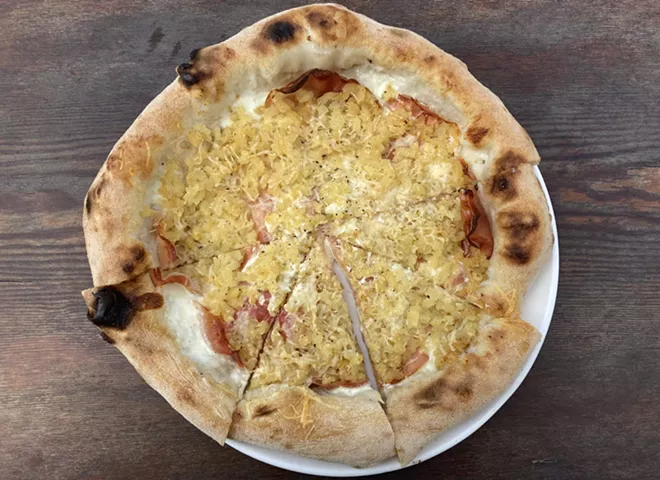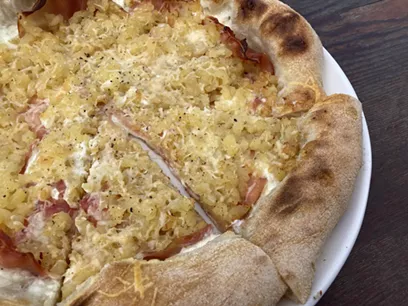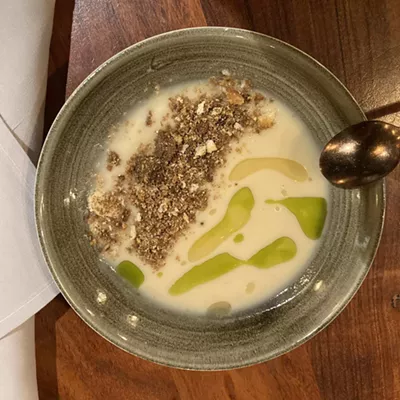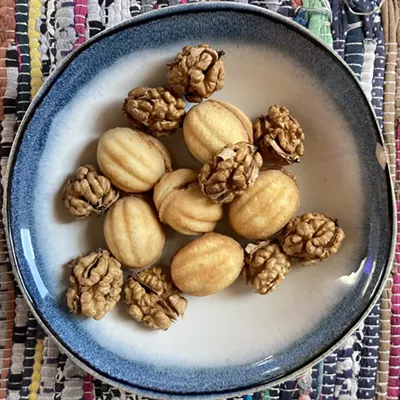
This is an installment of the Inlander's yearlong project "Around the World in 80 Plates," a quest to find 80 foods and drinks in the Spokane area representing 80 different places. Read the introduction to the project here.
Count of dishes/places: 39
Everyone knows that pizza is Italian. I'm not really breaking any news here.
BUT. Potatoes on pizza? Ma dai! Come on. Non è italiano, vero? That's not Italian, is it?
That's where you might be surprised.
Pizza Fiocco, a Napoletana-style pizza with ham and potatoes that originated at a famous Napoli pizzeria, is now available in Spokane.
In case you're skeptical, it's wonderful. All those carbs might put you to sleep, but that's the sign of a good meal, no?
You heard it here first, folks — these Italians seem to know what they're doing.
PIZZA FIOCCO FROM NAPOLI, ITALY
Steve Moss is somewhat of a research fanatic when it comes to making pizza. The head brewer at For the Love of God Brewing has only been making pizza for about a year-and-a-half, but he's managed to unearth some elusive tricks of the trade by following various Napoli pizzerias pretty closely.
Napoli (or Naples, as us Americans like to call it) is the presumed birthplace and therefore protector of pizza. A traditional Napoletana, or Neapolitan, pizza is quite literally protected by the European Union. Also called a Margherita pizza, it must be topped with either San Marzano tomatoes or grape tomatoes grown near Mount Vesuvius, plus mozzarella usually made from water buffalo milk.
But to Moss, all this regulation about toppings draws attention away from what distinguishes Napoletana pizza the most — the crust.
You won't find buffalo milk mozzarella at For the Love of God, or Mount Vesuvius tomatoes. You will, however, find a pizza that's impossibly thin in the middle surrounded by a uniquely puffy, light, chewy but crisp crust.
Making that crust is a labor intensive process that Moss has learned from Napoli pizzaiolos (pizza artisans) and still tweaks from time to time. It includes "biga," a dry pre-ferment dough, plus a 48-hour cold fermentation. Then, Moss adds enough water to take the dough up to 75% hydration, which is so sticky it's nearly impossible to work with.
But whatever you do, he says, protect that crust.
"You don't wanna touch the crust almost at all," Moss says. "You really don't wanna pinch it or anything. You're forcing that crust to get as much air in it as possible. Then, when you throw it in the high temp oven around 800 °F, the air expands really rapidly so it puffs that crust up."
The result is something like looks more like a bowl than a plate. It's something that Napoli pizzaiolos have been experimenting with more and more.
"Not all pizzerias in Napoli make crust that looks like that," Moss says. "It's maybe a little bit more of a modern thing in Napoli. That's why most places seem to call it contemporary Napoletana pizza."
Instead of shooting for a traditional Neapolitan flavor, Moss is offering a new but soon-to-be-canonized classic that first came on the scene in Napoli in 2003.
It starts with Roberto and Salvatore Susta, brothers and pizzaiolos at their restaurant Sustable in Volla, a city on the outskirts of Napoli. They wanted to create a new pizza, and started searching their childhood for inspiration.
The flavors of potato gateau, a

The result is incredibly rich and comforting, with the coziness of potatoes and pizza trying to outcompete each other for the ultimate creamy carb experience.
Sustable named the dish Pizza Fiocco, presumably because "fiocco" can mean flake, the perfect description of the soft, shredded potato flakes blanketing the crust.
Pizza Fiocco is now coveted across the globe. In 20 years, it's gained international fame and drawn tourists from the U.S., Poland, Germany, Holland, Chile, Finland and Russia to travel to Naples just to try it, according to Sustable's website.
Moss would never dare say that his Pizza Fiocco is the same as Susta's, which he's also traveled to try firsthand.
"I have a lot of respect for Roberto Susta and his passion for pizza," Moss says. "I followed him for quite a while on social media and stuff. So it was really cool to be able to go there and meet him and try his pizza."
As far as he can tell, no one else is making Pizza Fiocco in the Northwest. Even though it's not quite the same as at Sustable, Moss would say it's pretty close.
"We do ours slightly different than theirs," he says. "They do theirs with some type of ham — I've never even heard of that type of ham until I saw it on their menu. I'm not sure we can even get it in the U.S. We actually just use prosciutto on ours, so ours is a little different due to that. But I do think ours is very similar."
GELATO FROM SICILY; NUTELLA FROM PIEDMONT; AMARETTO FROM SARONNO
As if authentic Napoletana pizza wasn't enough, Moss also makes gelato from scratch. (Not to mention that he makes some crazy creative beers — they're not necessarily Italian, but fantastic nonetheless.) On any given day, he usually has vanilla and chocolate espresso on hand, but he'll always experiment with seasonal ingredients for limited edition flavors (think raspberry or persimmon).
Spokane is lucky enough to have multiple authentic gelaterias, not the least of which is Tre Palline Gelato Napolitano by Marco Napolitano, a "tecnico di gelato" with close to 40 years of experience.

When I ask Napolitano about the origins of gelato, he starts talking about ancient Sicilians storing snow in caves way back in 400 B.C.E. They would mix it with juices from their best-in-the-world citrus for refreshing summertime drinks, he says. When Arabs introduced sugar to the Mediterranean, the Sicilians eventually created an ice-juice-sugar combo called granita, a precursor to sorbet, which is a precursor to gelato.
Then, to check himself, Napolitano goes into the back and returns with Scienza e Tecnologia del Gelato Artigianale, what he calls the Bible of gelato making. There are about 70 pages dedicated to tracing the history of gelato, from the cold ancient caves to Bernardo Buontalenti, a chef in the late 1500s considered the father of modern gelato, and on to the first gelato fair in 1955.
The final step of making sure my research is super legit is trying Napolitano's gelato itself. I order two of my favorite Italian flavors — Nutella and amaretto, each of which have their own Italian origin stories.
In brief, Nutella was the result of a cocoa shortage after World War II. Brothers Pietro and Giovanni Ferrero owned a small pastry shop in Alba, a city in the Piedmont region of Italy. To make up for the lack of cocoa, they added a little bit of chocolate to a whole lot of ground hazelnut, which was much more readily available. They accidentally struck upon a combo that eventually became the greatest flavor in the whole entire world. Fact.
Amaretto is a sweet liqueur made from bitter almonds

All I know for sure is that, since the scoop of amaretto is underneath the scoop of Nutella, the bite of the alcohol kicks in just as the Nutella flavor reaches peak sweetness, which makes for the perfect balance of cocoa and booze. Mamma mia!
So, between pizza and gelato this summer, arrivederci worries. I'm going to skip on plane tickets and take a staycation — Spokane, it turns out, is practically Little Italy. ♦
Have an idea for what I should eat next? Wanna make me a traditional dish from your hometown? Send 80 Plates tips and ideas to elizab@inlander.com.


























